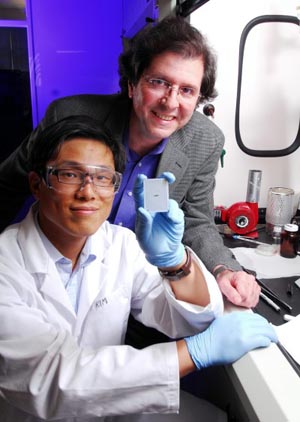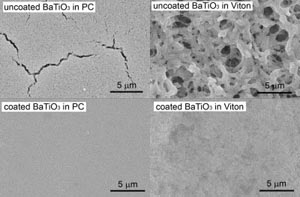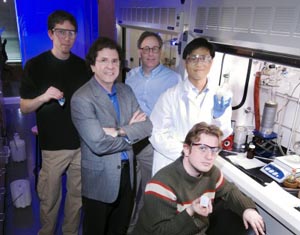One of the big problems facing society in its search for sustainable alternative energy sources is not how to harness wind, Solar, or wave power, but how to store the electricity produced using these elements at times of low demand. Capacitors could be the answer. These devices can be charged up very quickly, store electrical energy for long periods, and then be discharged rapidly for a range of applications. Such capacitors are on the horizon but their small-scale cousins are developing even faster for portable applications.
Researchers at the Georgia Institute of Technology have devised a new technique for making nanoparticulate films of the mineral barium titanate (BaTiO3) embedded in a polymer matrix. Barium titanate has a high dielectric constant which means it has a high electrical storage capacity. Capacitors made using this material could be used as an alternative to rechargeable batteries for electronic gadgets such as mobile phones, mp3 players, and PDAs.

Team member Philseok Kim and Joe Perry (right) show off their nanocomposite capacitor
However, there are problems with using crystalline barium titanate, so the GATech team has produced nanocomposites that have even greater potential. The new capacitor materials could store twice as much energy as current devices but allow a current to be tapped off at as rapid a rate as the device requires. High energy storage and rapid current discharge capacitors composed of these new materials would be lighter than conventional batteries and provide users with potentially much longer live time on their devices. They would also not suffer from the kinds of debilitating memory effects that render rechargeable batteries useless after a limited number of recharge cycles.
Our team has developed nanocomposites that have a remarkable combination of high dielectric constant and high dielectric breakdown strength, explains Joseph Perry, For capacitors and related applications, the amount of energy you can store in a material is related to those two factors.”

Scanning electron micrographs of barium titanate nanocomposites
Key to developing thin-film capacitor materials with higher energy storage capacity is the ability to spread the nanoparticles throughout the polymer support material as densely as possible. Barium titanate nanoparticles tend to clump together, which leads to electrical breakdown of the capacitor. To get around this problem, the team used organic phosphonic acids to encapsulate the nanoparticles. These tailored organic phosphonic acid ligands, designed by colleague Seth Marder and his team give the nanoparticles a tough coating that prevents aggregation.

Capacitor creators Peter Hotchkiss, Joe Perry, Seth Marder, Philseok Kim and Simon Jones
“Phosphonic acids bind very well to barium titanate and to other related metal oxides,” Perry explains, This allowed us to provide good compatibility with the polymer hosts.
The new composite materials could soon be used in commercial devices, but Perry wants to boost their performance still further before then. Perry and Marder are now working with Bernard Kippelen to find ways to use the nanocomposites in organic thin-film transistors too.
Further reading
Adv. Mater., 2007, 19, 1001-1005
http://dx.doi.org/10.1002/adma.200602422
Professor Joseph Perry
http://www.chemistry.gatech.edu/faculty/Perry/
Professor Seth Marder
http://www.chemistry.gatech.edu/faculty/Marder/
Suggested searches
sustainable energy
capacitors
composites